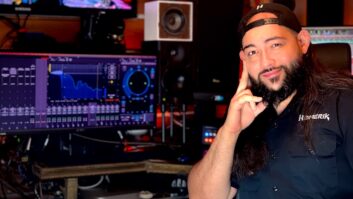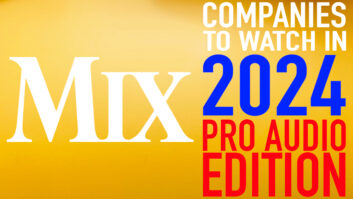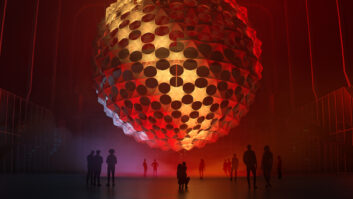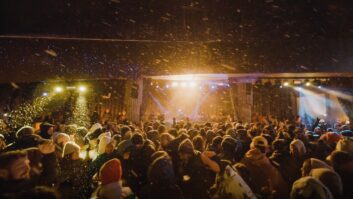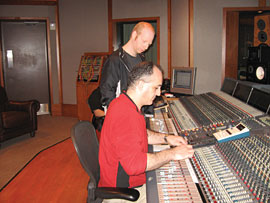
Oz Noy (standing) with engineer Eli Lishinsky at Bennett Studios.
Since relocating to New York City from his native Israel, guitarist Oz Noy (www.oznoy.com) has supported such artists as Harry Belafonte, Chris Botti, Toni Braxton and Jeff “Tain” Watts. But Noy is a distinctive artist in his own right. His edgy, urban sound is rooted in jazz and rock, but incorporates myriad influences. Following two solo releases, Oz Live (2003) and Ha! (2005), Noy has begun to be recognized for groove-based music that is also notable for his creative use of guitar effects and loops.
Like many recording artists, Noy must produce his albums on shoestring budgets. However, because he works with top-tier musicians and is highly particular about his guitar sound, Noy spends his money recording his groups live in premium commercial studio facilities as quickly as possible. “I couldn’t have an extra day or two in the studio,” Noy says. “I didn’t have the money, and it’s kind of good that I didn’t because it was a lot more focused.”
For his third release, Fuzzy (Magna Carta, 2007), Noy booked three sessions. Two took place at Bennett Studios in Englewood, N.J. — first with drummer Anton Fig and bassist Will Lee, and then with drummer Keith Carlock and bassist James Genus. A week later, Noy recorded at Mad Dog Studio in Burbank, Calif., with drummer Vinnie Colaiuta and bassist Jimmy Johnson.

West Coast sessions took place at Mad Dog Studio
Bennett Studios is a converted 100-year-old Victorian railroad station owned by Dae Bennett since 2001. “I just pay for the day and I can do whatever I want,” Noy says. “I wouldn’t record in a studio that [says], ‘You’ve got 10 hours and you’re out!’ It’s just too hard.”
Noy called on freelance engineer Eli Lishinsky for the sessions in Bennett’s North Room, which has a 25×47-foot live room, three iso booths and a Neve VR60 console. Lishinsky used Bennett’s older Pro Tools TDM system to take advantage of the studio’s Apogee AD-8000 AD/DA converters. Lishinsky used the room’s vast space to create sufficient isolation between the drums and guitar amps; drums were set up in one corner, to the far-left of the control room, while Noy’s amps were placed inside the iso booth in the farthest-right corner from the control room. Noy kept the door to the booth partly open to compensate for the feeling of isolation. “I stand by the door so at least I get some air moving between my guitar and amp,” he says. Noy used two Bad Cat amp heads connected to Celestion speaker components, and Lishinsky miked the amps with three pairs of mics: Shure SM57s up close, Royer R-121 ribbon mics slightly off-axis and about 10 inches farther back, and Neumann U87s for ambience.
Although Bennett offers a bountiful selection of outboard gear, Lishinsky mainly relied on the Neve VR60. “There was a Neve 1073 [EQ/preamp]. The kick and the snare went through it,” Lishinsky says. “I believe that everything’s supposed to sound natural. ”
Noy says that guitarist Lyle Workman recommended both Mad Dog and freelance engineer David Bianco to him. Mad Dog’s Studio A is a 2,500-square-foot space with high ceilings, a large iso booth and movable baffles. “They have a good mic selection, the outboard gear is really good — anything you’d really want is there.” says Bianco, who adapted the room to Noy’s project by placing Colaiuta’s drums inside the iso booth — which has wood floors and is surrounded by glass windows — and Noy’s amps in the main room behind baffles. “We decided that a real articulated drum sound would be the best thing,” Bianco says, “because Vinnie’s such a nuanced player that you want to get everything that he does. So the tight sound seemed to suit, although the iso room had enough ‘live-ness’ to it that I could blow it up with compression if I wanted to.” Bianco recorded bass direct, and employed a similar miking scheme on Noy’s dual guitar cabinet setup, using SM57s, R-121s and U67s. Bianco tracked the musicians through Mad Dog’s Neve 8088 console into a Pro Tools HD2 system.
Bianco used Mad Dog’s API 312 mic preamps and API 550 equalizers on the drums. “I would compress the kick drum with an 1176 compressor,” Bianco says. “On the drums I would maybe compress the overheads with dbx 160s, and I’d use Distressors on the room mics to blow them up a little bit. I own a Neve stereo compressor that I used on the room, as well. With Oz’s guitar stuff, I think I pretty much brought that through the 8088. There might have been a light amount of compression on the 67s on the cabinets, and that was probably 1176s, as well.”
Noy edited tracks in his personal studio and added keyboard overdubs from Shai Bachar, Jim Beard and George Whitty, as well as acoustic guitar overdubs (which were done at The POD Studio in New York City). He then brought the album to The Document Room in Malibu, Calif., where Kevin Shirley mixed it.
Bianco observes that Noy’s method of working quickly in high-end rooms and then editing at home reflects a new niche for commercial facilities. “There’s no budgets,” he says. “People were just saying, ‘We don’t need these studios; let’s just set up at home.’ Now everybody’s realizing, ‘Gosh, we don’t really sound like the Foo Fighters. Why is that?’ Well, because the Foo Fighters go to a real studio with real acoustic design, great mics and great front end. I think it’s coming back. I’d like to think that people need some guidance on how to make records and maximize what they have.”




